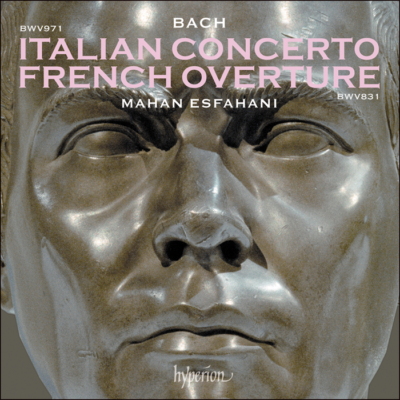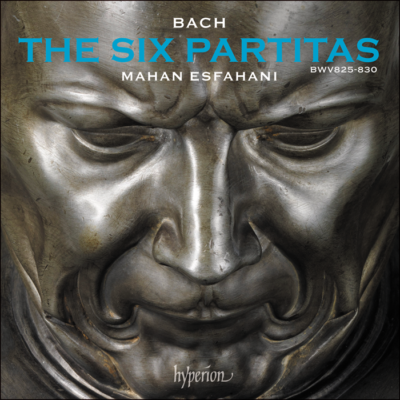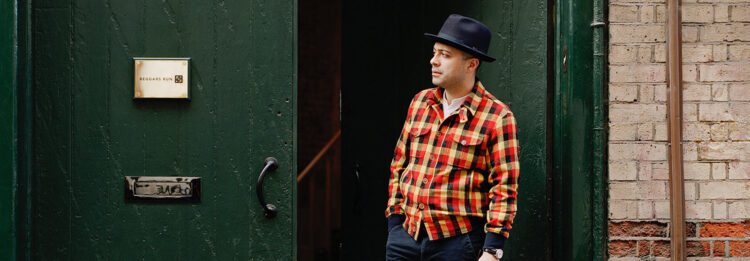by Steven Silverman
Published October 9, 2022
J.S. Bach, “The Six Partitas.” Mahan Esfahani, harpsichord. Hyperion CDA68311/2 (2021)
J.S. Bach, “Italian Concerto and French Overture” including Four Duets; Capriccio in B-flat, “On the Departure of his Beloved Brother”; and Capriccio in E, “In honorem Johann Christoph Bach II Ohrdrufiensis.” Mahan Esfahani, harpsichord. Two discs. Hyperion CDA68336 (2022)

It is a pleasure listening to Mahan Esfahani’s recordings of some of J.S. Bach’s most iconic music for solo harpsichord. These two recordings, from 2021 and 2022, are a logical, satisfying pairing and will be considered together.
We have here the first two volumes of the Clavier-Übung in their entirety, namely the Six Partitas (I), the French Overture (a.k.a. Overture in the French Style) and Italian Concerto (II). There’s also the Four Duets from Clavier-Übung III (the portion of the third volume that is playable on harpsichord) and, as filler, the two early Capriccios. The first three of the Clavier-Übung were published in the 1730s and represent the mature Bach’s majestic summary of high Baroque keyboard possibilities.

The first two volumes are also linked by their key scheme, namely a spiral of incrementally ascending and descending intervals—Bb-c-a-D-G-e (the six partitas)-F (Italian Concerto)—and the furthest intervallic stretch—a tritone B natural (French Overture).
Esfahani’s readings are exuberantly alive. Passagework is impeccably clean—his finale to the Italian Concerto is a true Presto, every note in place at a tempo joyously just short of frenetic. The Preambulum from the G major Partita is likewise admirably clean at a rapid tempo and uses paired fingerings (e.g. 3-2, 3-2) to produce perfect articulations in the many scale passages. Ornaments crackle. Extended melodic lines spin out naturally as if on a single breath, as in the gorgeous Sarabande and Allemande from the D major Partita (although I would have preferred the accompaniment of the Allemande to be played as a tenor-bass duet, as notated—rather than as a single voice).

Repeats, virtually all of which are observed, become occasions for imaginative variety, through changed registrations, differing articulations, and tasteful embellishments—often minimal, but occasionally florid, as in the reprise of the Minuet from the Bb Partita, where Esfahani goes to town, adding scales, roulades, and even changed melody notes, all to happy effect. He also adds multiple embellishments to the repeats of the Sarabande of the Overture in the French Style, which I found deeply expressive (albeit losing much of the feeling of the dance).
Esfahani’s sense of timing is excellent. He avoids rhythmic stasis through judicious use of rubato, staggering (playing one hand ahead of the other), and agogic accents, as in the opening of the Toccata from the E minor Partita, where he creates drama and momentum by varying the speed and pacing of the written-out arpeggiated figures.
Especially striking is his slow movement of the Italian Concerto. The usual approach is to play the quasi-ostinato accompanying left hand strictly in time and letting the gorgeous right hand melody play freely off that rhythm. Esfahani occasionally opts for the reverse, allowing the melody to determine the accompaniment’s rhythmic placement. Done inexpertly, this induces seasickness, but Esfahani makes it work. Discrete inégale in Bourée I of the French Overture is another nice rhythmic touch.
The heart of these two recordings are the Partitas and the French Overture, which can be considered, in effect, the seventh Partita. Esfahani’s readings are anything but safe or down-the-middle. Most striking is the harpsichordist’s take on the opening of the C minor Partita. Instead of the quasi-French overture with big block triadic chords and dotted rhythms as published, we get a semi-improvisatory fantasy with slowly arpeggiated chords (adorned with appoggiaturas) and no immediate sense of beat. This version reflects a manuscript from the 1760s of Johann Müthel, one of Bach’s last students. It’s a striking alternative. (Yet the performer’s choice to play the succeeding lyric episode metronomically, with hands precisely together, is uncharacteristically pedestrian.)
His registration choices are also out of the ordinary. Esfahani makes imaginative use of the buff (lute) registration, using it to accompany (as in the Tempo di Gavotta from the E minor Partita) or to solo (a nice touch for the stile brisée Bourée 2 of the French Overture). The performer typically uses a heavy registration (two eight-foot manuals plus the four-foot stop) for Courantes, unusual but adding some appropriate gravitas.
He frequently uses a 16-foot stop (so every note gets doubled in octaves). There are a few 18th-century instruments with this stop, so Esfahani’s use is not ahistoric. This registration creates a lot of sound and a fine frenzy (also an unfortunate resemblance to a circus calliope), which sometimes seems, to me, to go against the music’s character. The final movement of the C minor Partita is a Capriccio, and this heavy registration turns the cavorting theme, with its leaping tenths, into a bunch of ponderous pachyderms.
Likewise, using this extreme registration for the main Passepieds in the French Overture goes against the dance’s light-footed character. I also wonder about the use of this registration for the Gigue from the A minor Partita, where the tumult of sound does not, to my ear, enhance the rapid passagework. (Indeed, most of the Gigues are played a bit relentlessly—the exception being the Gigue from the French Overture, which is uncharacteristically stodgy, both in terms of tempo and gluey articulation.) On the other hand, juxtaposing the 16-foot registration with a single eight on repeats of the initial and concluding statements of the opening movement of the French Overture (i.e. the actual overture) works strikingly well.
Other choices are also out of the ordinary. Esfahani plays many of the Allemandes with a lot of pushing and pulling (almost stops and starts, examples being Allemandes of the C minor and A minor Partitas), a different take than the flowing, lyric reading which is more typical (and often more natural). He sometimes overholds notes almost to the point of sounding like a piano’s damper pedal, even to the point of running different harmonies together (throughout the Sarabande of the French Overture, and also in cadential passages in the D major Partita Allemande). He repeatedly rolls chords and plays ornaments ahead of the beat including prominent melodic ornaments, like those in the theme of the fugue of the E minor Partita’s Toccata.

This is against prevailing wisdom, and for good reason: the rhythm gets obscured and intended dissonances are turned into consonances. And playing dotted rhythms apart from triplets, as Esfahani does in the Tempo di Gavotta of the E minor Partita, sounds a bit fussy (the Minuet from the D major Partita and the G Major’s Allemande have this same notation and the performer plays the dotted rhythm as a triplet).
Esfahani splits the baby over whether to play the Gigue of the E minor Partita in duple or ternary time—dotted rhythm on first statement, “tripletized” on repeat, and the reverse for the piece’s second half—with liner notes setting out at interesting length why Bach’s notation is ambiguous and summarizing the scholarship surrounding this movement. Double dotting all of the big beats in the Overture of the French Overture is effective and likely reflects historic practice as well.
Double manual harpsichords appeared in Germany in the 1730s, and Bach explicitly requires one for the Italian Concerto and French Overture, notating piano and forte dynamics, and predicating much of the Italian Concerto and the entire Echo movement of the French Overture on contrasting registration effects.
Esfahani goes Bach one better in the slow movement of the Italian Concerto, using the buff (lute) stop to tellingly accompany the gorgeously played melody. As noted above, juxtaposing the 16-foot registration with a single eight-foot on the repeated statements of the French overture is another maximal contrast which, to my ears, really works.
Clavier-Übung III is primarily for organ, but Esfahani shows that the Four Duets included here are perfectly playable on harpsichord. Think two-part inventions on steroids. These pieces are harmonically innovative—Esfahani correctly points out that the canonic sections of BWV 803, in F major, strays into bitonality—and are unfailingly expressive. The performances are first rate.
The Clavier-Übung II and III disc is rounded out by Bach’s two earliest extant keyboard compositions, the two Capriccios, each bearing a title to a brother. The E major BWV 993—to Johann Christoph, the elder brother who took Sebastian in after their parents’ death, helped educate him, and gave him access to his music library—is a mélange of harmonic and contrapuntal excess, and gets from the performer an exuberant reading, complete with smilingly over-the-top registrations, like alternating 16-foot and lute stop registration for arpeggiated flourishes.
The programmatic BWV 992—‘on the departure of the beloved brother’ (probably Johann Jacob who joined the Swedish military and survived the Great Northern War)—also gets a fine reading that convincingly threads its way through the meandering music and brings humor and nice rhythmic snap to the post horn calls in the two concluding movements. Esfahani opts for a big thump on the final equivocal chord (the piece ends with a dissonance—a 6/4 chord—which leaves an open-ended effect) and it works just fine.
In an engaging video available on YouTube, Esfahani, explicitly echoing Glenn Gould, rejects the idea of a definitive reading. Like Gould, he rhetorically asks why make a recording to only play the same way as others, especially given a contemporaneous performing tradition which—as illustrated by the C minor Partita’s opening—can deviate significantly from the published score. Hence, the performances on these recordings are mostly single long takes with some provocative interpretive choices. They are of the moment.
This bristling spontaneity shines through and is one of these two recordings’ most attractive aspects. In the same video, Esfahani speculates that the Partitas, published in 1731 as the 46-year-old composer’s Op. 1, show Bach as a composer a bit less self-assured than one normally thinks, wanting to be Handel, writing in a cosmopolitan style for broad appeal, and specifically emulating such Handelian features as leavening the dances with a more operatic style, and including popular numbers along with the traditional Allemande-Courante-Sarabande-Gigue. It’s an intriguing thought which humanizes Bach’s magisterial compendia of Baroque keyboard possibilities.
Steven Silverman is a pianist and harpsichordist whose performances include concerts at Weill Hall in New York and the Salle Cortot in Paris. He and his wife, the violinist and violist Nina Falk, are co-founders of the Arcovoce Chamber Ensemble, now in its 23nd season, and for many years a resident chamber ensemble at Washington D.C.’s Phillips Collection.
More CD Reviews:
No posts




